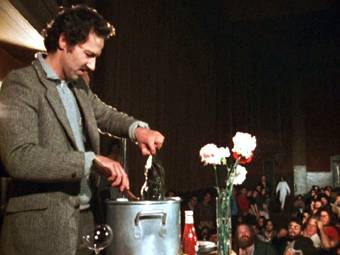Jean Renoir reminds me of the Robert Altman of the ’30s. His films have rich casts, authentic dialogue and concern society, class and order in different communities and settings. In “La Grande Illusion,” or the mistranslated English title “Grand Illusion” (it should be “The Great Illusion”), Renoir finds culture in of all places a World War I POW camp in Germany. Released just as tensions were getting high in Europe again, Renoir called it the last war of gentlemen.
As the movie starts, the Germans have shot down the French planes of Lieutenant Marechal (Jean Gabin) and Captain Boeldieu (Pierre Fresnay). “If they’re officers, invite them for lunch,” the Germans say. They sit and small talk, and for a moment you forget that their meal together came as the result of violence, death and being prisoners.
Perhaps also like “M.A.S.H.,” “La Grande Illusion” is a loose comedy, operating on pleasant banter, clever conversation and observations, peculiar situations and above all social customs.
Part of the movie’s feel has to do with the fact that there almost always seem to be about a half dozen people on screen at once. Renoir uses economical, understated cinematography to survey the room and surprise us when one character deserves our attention. It’s the little details we pick up that paint a picture of how bad this war is, like when one guy confesses that being a vegetarian and being in the war didn’t stop his wife from cheating on him, or when one soldier puts on women’s clothes and a wig and all the soldiers in the room stop dead in their tracks for a moment because they haven’t seen a woman in so long.
Both Marechal and Boeldieu lead escape attempts in the two POW camps they’re trapped in for seemingly no reason at all other than because it is necessary. If they do leave these fairly comfy confines, they’ll only have to go back to fight in what feels like an endless war, but prison camps are there to be broken out of. To not even try would be like betraying a social order.
What’s beautiful about the film is how utterly noble it is. The film has aged well over time because Renoir seems to predict in the film that royalty and class systems as they knew them in the time of the first World War will be obsolete from the world. The movie mentions that cancer and gout aren’t working class diseases yet, but they will be, and we realize how deep the societal structures once were. We see the enemy camp leader, Captain von Rauffenstein (Erich von Stroheim), showing genuine mercy as Boeldieu attempts to escape. We see Marechal learning his social skills outside of prison walls in a short sequence near the end that provides the film its heart. And for a film about war, it is free of virtually any violence, vicious acts or major tragedies, and yet it has great power.


